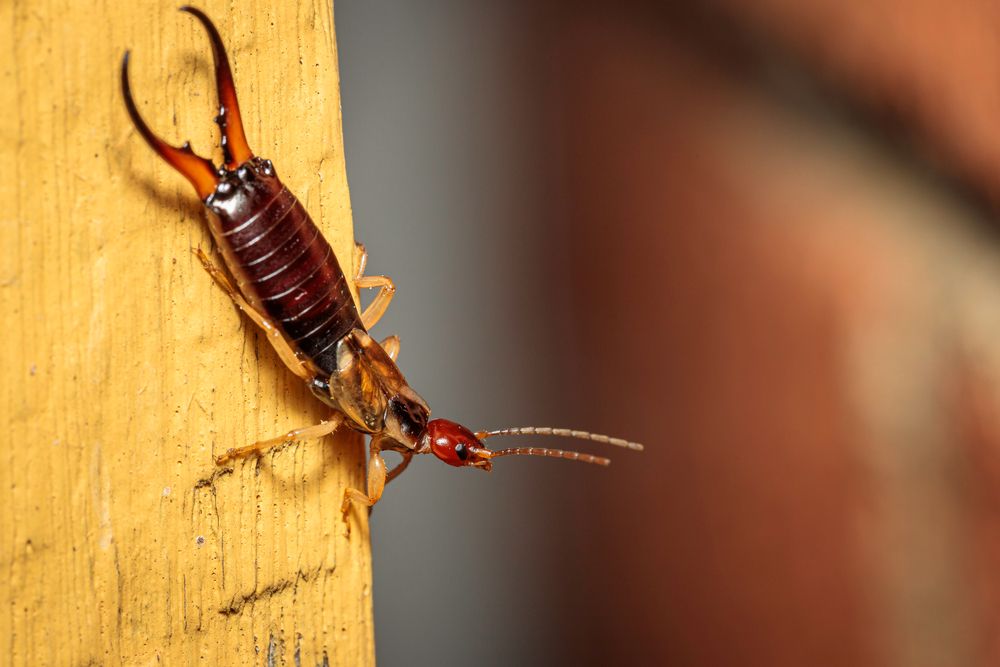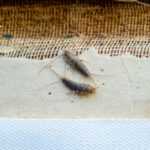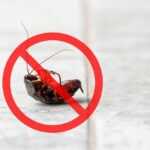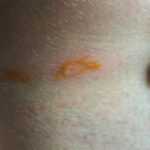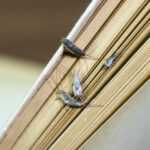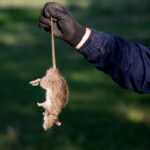Earwigs are nocturnal insects of small size which have a distinctive pair of pincers. Most earwigs inhabit moist, dark environments, and many species of earwigs exist worldwide. The European earwig, a common earwig species, often appears in gardens and homes, making it a well-known example of earwig behavior and impact.
This text provides information on earwig identification as well as their life cycle and behaviors, noting that the common earwig frequently appears in gardens and homes and affects gardens with its presence, along with control methods.
- The European earwig has a dark brown-black body with forceps-like pincers and prefers dark wet areas, which it inhabits during nighttime.
- Female earwigs start the life cycle by protecting their egg clusters while the eggs develop into hatching nymphs in late winter before the insects complete their development into adults.
- Outdoor trapping combined with proper garden cleanliness and gap sealing controls earwig infestations while acknowledging earwigs function both as garden pests and beneficial insects.
Identifying the European Earwig and Other Earwig Species
The European earwig reaches lengths of about 5/8 inch, making it a compact insect. Including their pincers, earwigs reach a total length of 3/4 inch (2 cm). The European earwig Forficula auricularia has a brownish-black coloration, including a dark brown body and a reddish head that creates an ominous look. Some earwig species, such as the tawny earwig, show variation among earwig species by having light brown coloration.
The European earwig Forficula auricularia displays its forceps-like cerci as its most distinguishing feature at the end of its abdomen. The pincers serve both defense purposes and mating activities. Earwigs have short leathery forewings, also called skin wings, that protect the delicate hindwings underneath. Although earwigs can fly, they prefer to move by crawling.
Both male and female earwigs show different characteristics in their pincers, which help identify their sex. Male pincers have a distinct curved shape resembling calipers, while female pincers remain straight. The pincers serve different purposes between the sexes, with male pincers showing increased curvature.
These distinctive characteristics enable proper identification of European earwigs. Earwigs’ nocturnal habits and preference for hidden dark places result in rare daytime sightings. These observations provide the foundation to study their life cycle and behavior, which prove equally intriguing. The European earwig is the most common earwig found in many regions, but other species may also appear. For example, the ring legged earwig shows a distinctive band on its forelegs.
Physical Characteristics and Habits of Earwigs
You can easily recognize earwigs by their elongated, flattened bodies and the prominent pincers, or forceps, extending from the tip of their abdomens. The common European earwig, one of the most widespread earwig species, typically measures about 5/8 inch in length. Its body is dark brown, complemented by a reddish head and pale yellow-brown legs, making it distinctive among other insects found in gardens and homes. Male earwigs have strongly curved pincers, more pronounced than those of females. These pincers serve multiple purposes, including defending against predators, capturing prey, and playing a role in courtship displays. While earwigs have membranous hindwings folded beneath short, leathery forewings, they rarely take to the air, preferring to crawl through their environments. The combination of their unique pincers, reddish head, and overall body shape makes the common European earwig easy to identify for homeowners and gardeners alike.
Life Cycle, Reproduction, and Development of Young Earwigs
Female earwigs place their eggs beneath the soil to start the life cycle. They create egg clusters containing 30 to 60 eggs. After laying, the eggs gain water content and expand to twice their original size until hatching. The eggs hatch after an incubation period, usually in May, and the mother continues to protect and assist the young nymphs during this vulnerable stage. The female earwig cleans the eggs to protect them from mold and external threats while providing motherly care. She moves the eggs to different locations to create suitable conditions for hatching. Notably, one species of earwig shows particularly elaborate maternal care, demonstrating unique reproductive behavior among earwigs.
Nymph Development and Seasonal Patterns
The hatched young earwigs, called nymphs, undergo incomplete metamorphosis as they develop, progressing from nymph to adult without a pupal stage. Before reaching adulthood, these nymphs go through multiple instar stages. The nymphs resemble adults but have underdeveloped wings. Their body color changes from grayish brown to dark brown as they develop into different earwig species.
The seasonal pattern of earwigs shows an intriguing life cycle. Optimal conditions in British Columbia allow nymphs to develop into adults during August. Earwigs lay eggs in late winter, and hatching occurs during May. The annual life cycle produces one earwig generation, while adults survive winter until the following breeding season.
Understanding the life cycle pattern of European earwigs provides essential knowledge about their population and behavioral patterns. This knowledge enables the development of effective management strategies, which we discuss in the following sections. Studying these behaviors and habits helps scientists discover where the species hides and its ecological role. This understanding naturally leads researchers to study their effects on plants and gardens, where they exist as both pest insects and beneficial species.
Diet, Foraging Habits, and Impact on Plant Pests and Gardens
Earwigs are omnivorous insects with a varied diet that includes decaying plant material, living plants, and other insects. Their nocturnal habits mean they forage mostly at night in dark, moist environments where they find both food and shelter. The European earwig, in particular, plays a dual role in the garden: it feeds on plant pests such as aphids and mites, acting as a beneficial insect by helping control pest populations. However, earwigs can also become plant pests themselves, especially when feeding on young plants, seedlings, or vegetable crops, sometimes causing noticeable damage. Observers have seen earwigs feed on a range of living plants and decaying plant matter, which helps recycle nutrients in the ecosystem. Their flexible diet allows earwig populations to thrive in various habitats, but gardeners and farmers need to monitor their presence to prevent unwanted damage to crops and ornamental plants.
Managing and Controlling Earwig Populations Outdoors and Indoors
Outdoor Trapping and Baiting Techniques
Implementing trapping techniques effectively manages outdoor earwig populations. Traps that use food bait, such as wheat germ and vegetable oil, attract and capture earwigs. Corrugated cardboard, especially when rolled or laid flat, provides ideal hiding places for earwigs and serves as a low-cost trap when combined with bait. Extension entomologists and research from Colorado State University recommend these baiting and trapping methods as part of integrated pest management for earwigs.
Garden Cleanliness and Moisture Control
Keeping gardens clean and maintaining proper watering methods to keep plants dry help prevent earwig presence. Eliminating damp and moist conditions, especially around rain gutters, air conditioning units, and house foundations, limits earwigs. Removing sheltering debris and maintaining dry garden conditions reduce earwig population numbers. Sealing window sills and using caulking compound to block other entry sites further prevent earwigs from entering indoor spaces.
Natural Predators and Biological Controls
Attracting natural predators such as frogs and birds, along with biological controls like parasitic tachinid flies, can control earwigs outdoors. These methods provide environmentally friendly solutions that protect the ecosystem from damage.
Use of Insecticides and Barrier Treatments
Applying diatomaceous earth creates an earwig-killing barrier by causing dehydration. People should use insecticides cautiously because they might harm beneficial insects, but barrier treatments near entry points work best for their application.
Sealing Entry Points and Indoor Prevention
Sealing all gaps and cracks on your house exterior stops earwigs from entering. Using weather stripping around doors and windows prevents earwigs from accessing indoor areas. Regular inspection and maintenance of these seals provide continuous protection against pest infestations.
Earwigs depend on moist environments, so maintaining dryness and proper ventilation in basements, bathrooms, and kitchens is essential. Eliminating damp and moist conditions prevents infestations. Removing sheltering debris such as stacks of newspapers or old boxes reduces available hiding places. Reducing hiding places and sealing other entry sites is essential for indoor prevention.
Combining preventive measures establishes an environment that makes it difficult for earwigs to survive, protecting your home from household pests. This natural progression enables us to examine widespread myths and false beliefs regarding these insects.
Common Myths and Facts About Earwigs
The term ‘earwig’ originated from an outdated notion that these insects would burrow into human ears to consume brain tissue. This untrue claim has spread through time despite lacking scientific support. Earwigs rarely invade human ears, and when they do, the events produce no serious results.
Despite numerous reports of earwigs entering human ears, researchers have found no scientific evidence supporting permanent damage. Earwigs remain mostly harmless because they almost never bite humans. Their pincers, though intimidating, do not cause pain.
Clarifying these myths leads to a better understanding of what earwigs truly are. This allows examination of earwigs in literature and folklore after clearing up misconceptions.
Earwigs in Literature and Folklore
Stories and illustrations have created a negative public perception about earwigs through folklore. People started calling these insects ‘earwigs’ because they believed the insects would invade sleeping persons’ ears to eat their brain tissue. This belief contributed to their mythical fear.
Popular culture depicts earwigs in various forms, including movies like ‘Star Trek: The Wrath of Khan,’ where they appear as fearsome creatures. These depictions reinforce the mythical fear surrounding them.
Earwigs appear as both terrifying insects in traditional folklore and misunderstood insects in contemporary times. Understanding their importance in our ecosystem leads us to summarize the key points presented.
To identify the European earwig, recognize its size, coloration, and distinctive features like pincers and wings. The egg-laying and nymph stages of their life cycle reveal their growth and population dynamics.
Earwigs only cause minor plant pest damage but help by eating plant pests. Effective control methods include trapping, maintaining garden cleanliness, and encouraging natural predators. Preventing indoor infestation requires sealing cracks and entry sites, eliminating damp conditions, and using outdoor strategies to limit earwigs.
Understanding the true nature of earwigs and their cultural significance in folklore helps debunk myths about them. Understanding these aspects helps us better manage earwig populations and learn to coexist with these fascinating insects.
Frequently Asked Questions
Why do earwigs enter your house?
Earwigs seek homes for food and shelter because they need dry conditions to survive. To prevent their entry, keep your house free from decaying organic matter and maintain clean plants.
How can I identify a European earwig?
You can identify European earwigs by their dark brown to black color, length of approximately 5/8 inch, and distinctive forceps. Recognizing these features confirms the insect’s identity.
Are earwigs capable of crawling into people’s ears?
Although earwigs might occasionally crawl into people’s ears, this uncommon event usually does not cause injury.
How do earwigs impact gardens?
Earwigs cause minor damage by punching small holes in plants and fruits but serve as a helpful resource by consuming garden pests such as aphids. Their effect on garden ecosystems contains both detrimental and positive elements.
What are the most effective ways to manage earwigs in outdoor settings?
You can effectively control earwigs outdoors through trapping, reducing garden moisture, and encouraging natural predators. These measures help manage their population efficiently.
